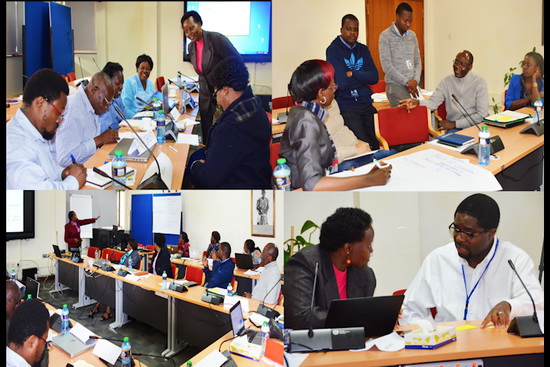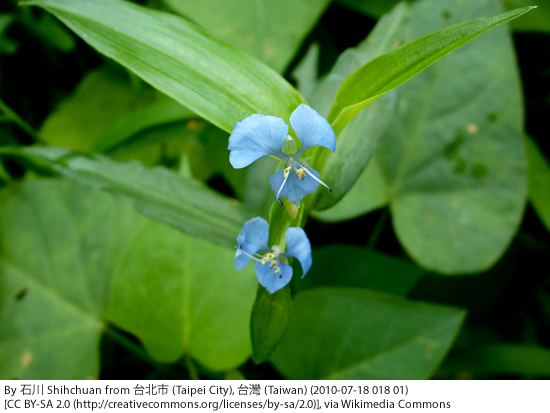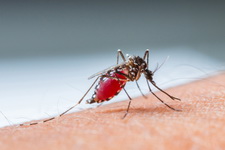
CROP BIOTECH UPDATE
---------------------------------------------------------------------------
A weekly summary of world developments in agri-biotech for developing countries, produced by the Global Knowledge Center on Crop Biotechnology, International Service for the Acquisition of Agri-biotech Applications SEAsiaCenter (ISAAA)
---------------------------------------------------------------------------
July 20, 2016
In This Week’s Issue:
News
Global
• FAO Seeks to Bridge Gap between Agri and Forestry to Improve Food Security
Africa
• BecA Director Asks Scientists to Tell the World about their Research
• Kenyan Senator Urges Adoption of GM Crops in the Country
Americas
• Scientists Share Advances in Alfalfa Genome Research
• U.S. House of Representatives Passes GM Food Labeling Bill
• Herbicide Resistance Predates GM Crops, Says Weed Scientists
Europe
• Research Team Explains How Plants Can Grow on Saline Soils
• International Team of Scientists Release Whole Genomes and Epigenomes of More than 1,000 Arabidopsis Plants
Research
• SAPK9 Improves Drought Tolerance and Grain Yield in Rice
• Agrobacterium rhizogenes Genes Induce Dwarfism in Arabidopsis
• Overexpression of Alfalfa TMT Increases α-Tocopherol content in Arabidopsis Seeds
Beyond Crop Biotech
• Scientists to Harness Plant Microbiome to Improve Food Supply
• Researchers Develop First Step Toward Controlled Gene Therapy
• GM Mosquitoes Reduce Dengue Fever Cases by 91% in Piracicaba, Brazil
Announcements
• 2nd International and 14th National Iranian Crop Science Congress
----
NEWS
----
Global
FAO SEEKS TO BRIDGE GAP BETWEEN AGRI AND FORESTRY TO IMPROVE FOOD SECURITY
Agriculture is known to be the most influential driver of global deforestation, but positive interactions between agriculture and forestry are achievable and necessary to build sustainable agricultural systems and enhance food security. This is the main point of the publication titled The State of World Forests (SOFO), released by the Food and Agriculture Organization of the United Nations (FAO). The report was launched during the 23rd Session of the FAO Committee on Forestry (COFO).
"The 2030 Agenda for Sustainable Development, as well as the Paris Agreement on climate change, recognizes that we can no longer look at food security and the management of natural resources separately," said José Graziano da Silva, FAO Director-General, during his opening remarks at the COFO Session. "Both agreements call for a coherent and integrated approach to sustainability across all agricultural sectors and food systems. Forests and forestry have key roles to play in this regard…The key message from SOFO is clear: it is not necessary to cut down forests to produce more food," he added.
According to SOFO, seven countries (Chile, Costa Rica, Gambia, Georgia, Ghana, Tunisia and Vietnam) have shown that improving food security can be achieved while maintaining forest cover. Six of these countries achieved positive change in the period 1990-2015 in two food-security indicators - the prevalence of undernourishment and the number of undernourished people - as well as increases in forest area. The Gambia, the only low-income country among the seven, succeeded in achieving the first goal of halving the proportion of hungry people within the same period.
Get more information about the SOFO from FAO.

 Senate Education Committee Chairman, Honorable Daniel Karaba, has urged Kenya to take up biotechnology to boost food security. Speaking at a biotech communication and sensitization training for journalists and extension officers held on July 7-8, 2016 at Mountain Breeze Hotel in Embu County, Eastern Kenya, Hon. Karaba said that countries that had embraced biotech crops are more food secure and have a thriving economy. He dismissed reports that attribute cancer to GM foods.
Senate Education Committee Chairman, Honorable Daniel Karaba, has urged Kenya to take up biotechnology to boost food security. Speaking at a biotech communication and sensitization training for journalists and extension officers held on July 7-8, 2016 at Mountain Breeze Hotel in Embu County, Eastern Kenya, Hon. Karaba said that countries that had embraced biotech crops are more food secure and have a thriving economy. He dismissed reports that attribute cancer to GM foods.A team of researchers from the Noble Foundation, University of Minnesota, and the National Center for Genome Resources reports new developments in sequencing the alfalfa genome on July 13 at the North American Alfalfa Improvement Conference in Madison, Wisconsin.
Dr. Maria Monteros, Noble Foundation associate professor in legume breeding said that the alfalfa genome is one of the most complex plant genomes to sequence. The team reports that as a legume, alfalfa can satisfy its nitrogen needs through its symbiotic relationship with rhizobia. This important trait removes the need for additional nitrogen fertilizer inputs to support plant growth. Understanding alfalfa's genome sequence could lead to plants that could survive in stressful environments such as drought and animal grazing. It could also produce higher biomass yields when baled as hay, extend its growing season, and adapt better to different soil types and nutrient levels.
Dr. Joann Mudge, National Center for Genome Resources senior research scientist said, "We have made significant progress on the project as genomicists are putting the final pieces into place. Researchers may now be able to use the information for practical purposes to support plant breeding decisions."
For more information, read the news release at the Noble Foundation website.
 American farmers, producers, and other agri-business stakeholders welcomed the passage of the National Bioengineered Food Disclosure Standard by the House of Representatives. The legislation is expected to provide a transparent and uniform national food labeling standard. The bill now goes to President Barack Obama to be signed and passed into a law.
American farmers, producers, and other agri-business stakeholders welcomed the passage of the National Bioengineered Food Disclosure Standard by the House of Representatives. The legislation is expected to provide a transparent and uniform national food labeling standard. The bill now goes to President Barack Obama to be signed and passed into a law.
"Genetic engineering is one of a wide array of safe and important tools plant breeders use to address global challenges. Thanks to this bill, products produced through this method will not be unfairly stigmatized with mandatory on-pack labels," said Andy LaVigne, president and CEO of the American Seed Trade Association.
"Today, our representatives in the House built upon last week's work in the Senate, taking another important step toward bringing consistency to the marketplace," said Chip Bowling, a farmer from Maryland and president of the National Corn Growers Association (NCGA). "This achievement was made possible as members of the food and agricultural value chain came together as never before to advance a solution that works for farmers, food companies and, most importantly, consumers... Now that both houses of Congress have come together to address this important issue, we ask that the President take the final step by signing this legislation into law," he added.
For more details, read the news stories from NGCA and Seed World.
Herbicide resistance has been blamed to glyphosate use in genetically engineered crops. However, the Weed Science Society of America (WSSA) reports that herbicide resistance predates genetically engineered crops by 40 years. According to a WSSA press release, while 2016 marks only the 20th anniversary of glyphosate resistant crops, 2017 will mark the 60th anniversary of the first reported herbicide resistant weeds.
The first known case of herbicide resistance was reported in 1957 when a spreading dayflower in Hawaii was found to be resistant to a synthetic auxin herbicide. The same year, a wild carrot in Ontario, Canada was found to be resistant to some of the same synthetic auxin herbicides. Since then, 250 species of weeds have evolved resistance to 160 different herbicides that span 23 of the 26 known herbicide mechanisms of action, and they are found in 86 crops in 66 countries.
Research shows that resistant weeds evolve when a single approach to weed management is used repeatedly to the exclusion of other chemical and cultural controls – making a diverse, integrated approach to weed management the first line of defense. Many growers have successfully fought resistance by adopting a broader range of controls.

For more details, read the press release at the WSSA website.
Scientists from the University of Würzburg in Germany have examined how plants regulate their salt intake. Salt consists of the cation sodium and the anion chloride. Higher doses of chloride in saline soils have toxic effects on plant development. However, plants need the anion nitrate as a nitrogen source to build proteins and multiply their DNA. Würzburg plant scientists Dietmar Geiger and Rainer Hedrich studied whether and how plants are capable of distinguishing between the nutrient nitrate and the harmful chloride.
The researchers identified the two anion channels SLAH1 and SLAH3 found in plant cells, which are responsible for regulating the passage of nitrate and chloride. Working with a Spanish group, the scientists studied genetically modified plants in which SLAH1 or SLAH3 is missing. The sap of these plants ascending to the shoot only contained half the amount of chloride ions. The nitrate content, however, remained unchanged, giving the conclusion that both anion channels regulate the entry of chloride into the shoot.
The researchers found SLAH1 incapable of conducting anions, and SLAH3 mainly conducts nitrate. The contradiction between the nitrate and chloride contents in the sample plants and in the genetically modified plants was resolved when the two anion channels were brought together, forming a functional complex. Each time SLAH1 enters the complex, the anion filter in SLAH3 will switch from nitrate to chloride and vice versa. The role of this switch was determined by the Spanish team. They observed that the higher the salt load the roots of the sample plants were exposed to, the more SLAH1 was withdrawn from the anion channel complex. In the process, the chloride-conducting complex gradually evolves into a nitrate-conducting status, allowing the plant to maintain its nitrate intake as a vital source of nitrogen without taking damage by the salinization-related increase in chloride concentration.
For more details, read the news release at the University of Würzburg website.
Thale cress (Arabidopsis thaliana) is a favored research subject for plant science. Much of today's knowledge about the inner workings of plants comes from studies in this unimposing, but globally distributed weed. In a major milestone, the "1001 Genome Project", led by Detlef Weigel from the Max Planck Institute for Developmental Biology in Tübingen, Germany and Magnus Nordborg from the Gregor Mendel Institute of Molecular Plant Biology in Vienna, Austria, has recently completed the genome sequences from 1,135 individuals collected all over the world.
The new results revealed previously unappreciated aspects of the evolutionary history of this important model plant. Based on the genetic differences, the research team identified six different groups of modern Arabidopsis plants, with the vast majority belonging to a group that has evolved after the last ice age and then spread fast around the world, just as the modern human.
Weigel says the other five groups are like Neanderthals amongst the plants, and evolved before the last ice age and have survived as isolated, genetically differentiated populations on the Canary and Cape Verde islands, on Sicily, in North Africa and throughout the Iberian Peninsula. These relicts are restricted to more natural, undisturbed habitats, explaining their much more limited modern distribution.
More information and access to all data are available at the 1001 Genomes Project website.
The members of the sucrose non-fermenting 1-related kinase 2 (SnRK2) family make up the core of abscisic acid (ABA)-dependent and -independent signaling pathways, and are also involved in regulating abiotic stress response in plants. The team of Avishek Dey of the Indian Institute of Technology Kharagpur recently characterized the SAPK9 gene, a SnRK2 of rice.
Analysis revealed that SAPK9 expression was higher in drought-tolerant rice and was higher in reproductive stage than the vegetative stage. The highest expression was found in leaves and the gene was upregulated during drought stress and ABA treatment. Overexpression (OE) of SAPK9 from O. rufipogon in drought-sensitive indica rice improved its drought tolerance compared to wild types.
Upregulated expressions of ABA-dependent stress-responsive genes and increased sensitivity to exogenous ABA of OE lines indicate that SAPK9 is a positive regulator of ABA-mediated stress signaling pathways in rice. The boosted yield-related traits of OE lines were a result of high pollen fertility in OE lines.
The SAPK9 gene has potential use in developing improved drought tolerance and grain yield in crops.
For more information on this study, read the full article in BMC Plant Biology.
Plant transformation using the Ri plasmid T-DNA of Agrobacterium rhizogenes is a promising technique for developing compact plants. However, knowledge of this technique is still limited. The rolB and ORF13 genes of A. rhizogenes show promise in breeding, but have not been studied. Researchers from the University of Copenhagen in Denmark evaluated the morphological impact of specific genes of the Ri plasmid in order to study and hopefully optimize plant transformation using the Ri plasmid T-DNA.
RolB and ORF13 were inserted into Arabidopsis thaliana and their effects were assessed. rolB-lines exhibited dwarfing, early necrosis of rosette leaves, altered leaf and flower morphology, and developed an increased number of inflorescences per rosette area. On the other hand, ORF13-lines were extremely dwarfed, attaining only 1% of the rosette area of the wild type. Leaf and flower size was also reduced, and the shape was modified.
The rolB oncogene yield plants with increased formation of generative shoots, however, also results in premature senescence of vegetative organs. The extreme dwarfism seen in ORF13-lines suggests that this gene is vital in dwarfing response of plants transformed using Ri plasmid T-DNA.
For more information, read the article in BMC Plant Biology.
Vitamin E is an essential vitamin obtained from diet for proper growth and development. γ-tocopherol methyltransferase (γ-TMT) which catalyzes the conversion of δ- and γ-tocopherols into β- and α-tocopherols, respectively, is the final enzyme involved in the vitamin E pathway. Researchers from the Chinese Academy of Agricultural Sciences, led by Jishan Jiang overexpressed Medicago sativa's γ-TMT in (MsTMT) in Arabidopsis in hopes of improving the plant's vitamin E content.
The overexpression of MsTMT increased the α-tocopherol content 15 times higher than that of wild type Arabidopsis seeds without altering the total content of vitamin E. Interestingly, the biomass and the expression levels of several osmotic marker genes were significantly higher in the transgenic lines.
Meanwhile, overexpression of MsTMT in alfalfa led to a slight but significant increase in α-tocopherol in leaves and also resulted in delayed leaf senescence. The crude protein content was also increased. This indicates that the increase in α-tocopherol occurred in transgenic alfalfa without compromising the nutritional qualities.
MsTMT overexpression provides a promising method in improving the α-tocopherol content of crops.
For more information on this promising study, read the article in Plant Science.
Scientists from Duke University are exploring on how to manipulate plant microbiome to increase food supply. Plants, similar to the human body, are inhabited by millions of microscopic bacteria and fungi which affect plant health, growth, and development. Previous findings have exhibited that plant's genes can manipulate the microbiome in the lab, but only a few studies have measured such genetic control in the field.
"There can be thousands of different kinds of bacteria within a single leaf," said first author Maggie Wagner, graduate student at Duke during the time of the study. "The question is: what factors influence the microbes that end up living inside the plant?"
Wagner and colleagues used DNA sequencing techniques to elucidate the relative effects of plant genes, environment and other factors on microbiome. They specifically used spindly wildflower (Boechera stricta) in the study. They germinated genetically identical lines of the wildflower which were transplanted in three experimental gardens. After two to four years, they harvested the plants and sequenced the bacterial DNA in the roots and leaves of 440 plants. About 4,000 types of bacteria were found living inside the plants, mostly in roots. The most common bacterial groups found belong to Proteobacteria and Actinobacteria. They also found that on the average, about 5 percent or less of the variation in microbial diversity was influenced by plant genetics. The plant's genetic control on the microbiome was stronger in the leaves that in the roots. Soil pH, moisture, and temperature were found to be the major environmental factors that determined the plant's bacterial makeup.
"Microbiomes could be a very useful tool for improving agricultural productivity in the face of population growth and climate change," Wagner said, "but designing an effective breeding program could be a lot harder than some people think it is."
Read the news article from Duke University.
The ability to switch disease-causing genes on and off remains a fantasy. However, a team of researchers from Charité – Universitätsmedizin Berlin and the Max Planck Institute for Medical Research in Heidelberg may have just turned this into reality. Led by Dr. Mazahir T. Hasan, the team has programmed a virus to transport the necessary genetic material to affected tissues and deliver instructions to the host without becoming part of it.
"We use attenuated, non-replicating viruses known as recombinant adeno-associated viruses (rAAV). We use them to transport genetically encoded material into live organisms affected by disease," explains Dr. Hasan. "This approach opens up a whole range of options which, in the future, may allow us to treat and heal various diseases."
RAAVs can transport genetically-encoded material into any type of cell and tissue and are capable of repeatedly switching gene therapy applications on and off again. This on/off switch is controlled chemically, via food intake or drinking water. RAAV-infected cells also do not trigger any immune response and their genetic material remains intact.
For more information, read the article in Nature.
 A year after the genetically modified Friendly™ Aedes mosquitoes were launched in Piracicaba, Brazil, the Epidemiologic Surveillance service released new data which showed a 91% reduction in dengue fever cases in the CECAP/El Dorado District. Dengue fever cases decreased to just 12 in 2015/2016, against the 133 cases in the previous year. According to Epidemiologic Surveillance, the rest of the municipality saw a 52% reduction in dengue fever incidence during the same period, from 3,487 cases in the 2014/2015 period to 1,676 cases in 2015/2016.
A year after the genetically modified Friendly™ Aedes mosquitoes were launched in Piracicaba, Brazil, the Epidemiologic Surveillance service released new data which showed a 91% reduction in dengue fever cases in the CECAP/El Dorado District. Dengue fever cases decreased to just 12 in 2015/2016, against the 133 cases in the previous year. According to Epidemiologic Surveillance, the rest of the municipality saw a 52% reduction in dengue fever incidence during the same period, from 3,487 cases in the 2014/2015 period to 1,676 cases in 2015/2016.
The report also showed that in 2015/2016 dengue-year, the rate in CECAP/El Dorado was 45% lower than the rest of the municipality, whereas it was 195% larger in the previous year. The latest data roundup also reports zero cases of Zika and chikungunya in CECAP/Eldorado.
"Over the course of one year, we were able to bring the dengue fever incidence down by more than 50% in Piracicaba. In CECAP/Eldorado, where we had the Friendly™ Aedes project, the reduction was extraordinary, going over 90%," says Pedro Mello, the city's Secretary of Health.
Produced by Oxitec do Brasil, Friendly™ Aedes have been used in Piracicaba since April 30, 2015, when the first insects were released in CECAP/Eldorado. For more details, read the news release at the Oxitec website.
What: 2nd International and 14th National Iranian Crop Science Congress
Where: University of Guilan, Rasht, Iran
When: August 30 - September 1, 2016
For more information, visit the event website.